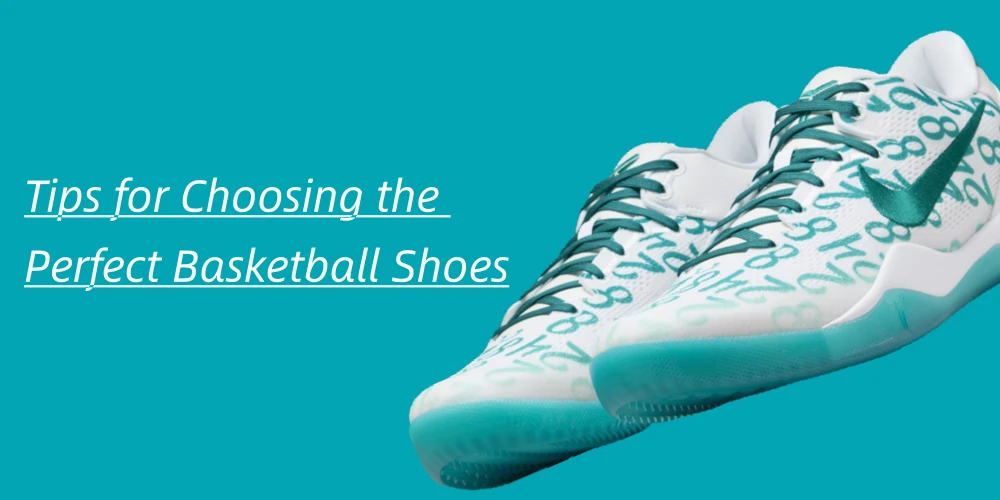Sneaker Culture
Tips for Choosing the Perfect Basketball Shoes
Basketball is a game that involves jumps, abrupt movements, and quick landings. Therefore, your basketball shoes work as the first line of defense by providing stability and support on your feet. Shoes that fit snugly lower the risk of injuries and prevent accidental spills. But the benefits go beyond that. Proper footwear improves agility – you can accelerate and pivot with confidence. Your performance and overall effectiveness on the court are largely influenced by the shoes you wear.
Understanding Basketball Shoe Anatomy
The upper
Some are made of leather others feature synthetic materials or a combination of both. A few models come with design elements (mesh panels, straps, and overlays).
The upper wraps the feet during jumps and lateral movements.
Midsole
The midsole features unique materials like polyurethane or EVA. A brand like Nike Air uses specialized cushioning technologies to enhance your comfort.
The midsole prevents excessive rolling of the feet by absorbing impacts. A high-quality midsole reduces strain on knees and feet.
Outsole
The outsole features unique grooves to enhance multidirectional movement. Shoes with durable outsole will help you make quick changes in direction and maintain quick cuts.
The outsole distributes pressure across the foot to reduce fatigue and enhance comfort.
Heel counter
Located at the rear of your footwear, the heel counter lessens the risk of heel slippage and promotes proper alignment of the foot. It has a plastic or TPU construction to stop your feet from moving side-to-side.
The heel counter improves balance during quick stops and provides a secure base for the foot.
Key Features to Consider
Traction
Basketball shoes have patterns that offer multidirectional grip. Herringbone patterns resemble zigzagging grooves to prevent traction on various surfaces. Some brands come with hexagonal or circular patterns to provide adequate grip on court surfaces. Others feature chevron patterns (triangular shapes) that grip dusty surfaces.
The common materials used for outsoles are:
- Gum rubber – it has a sticky texture to provide grip on smooth surfaces.
- Carbon rubber – it provides traction on courts made from asphalt or concrete
Cushioning
Well-known brands have made investments in cutting-edge cushioning technology to improve wearer support and performance. For example, Nike Air uses Air cushioning technology to reduce impact shock. In contrast, Adidas uses thermoplastic polyurethane to give each stride a springy feel.
The New Balance features fresh foam cushioning to provide a natural ride. It conforms to the shape of the foot without compromising stability.
Asics Gel – the midsole uses gel inserts to provide targeted cushioning. They are strategically placed in high-impact areas.
Brooks DNA AMP – uses TPU cushioning technology to amplify the energy you generate on each stride. The TPU casing further enhances propulsion and responsiveness.
Stability
Stability in basketball shoes helps players make sudden stops, lateral movements, and changes in direction. For instance, high-top shoes prevent excessive ankle movement to reduce the risk of injuries during landings. They allow a customizable fit to minimize slippage.
Low-top basketball shoes prioritize speed and agility. Since the collar sits below the ankle, these shoes reduce fatigue during intense activities. On the downside, they offer less ankle support.
Durability
Did you know that the lifespan of a basketball shoe is influenced by the choice of materials and construction method used?
Leather is a unique material that holds up well against abrasion. By contrast, synthetic materials tend to outperform their natural counterparts in longevity.
If you care about durability, you should invest in footwear with reinforcements, especially on the sidewalls and heel counter. Materials like solid rubber, carbon rubber, and blown rubber compounds improve durability.
Fit and Comfort
To find the perfect size of basketball shoe, you should:
- Know your size – use measurements as a guideline to understand the various brands. Try different sizes.
- Measure your feet – use a ruler to take measurements while standing.
- Consider the width – some brands are designed to accommodate different foot sizes. If you have wide feet, look for models that offer standard, wide, and narrow-width options.
- Check the toe room – your toes should have enough room to wiggle. Aim for a thumb width (your toes should not feel compressed).
- Look at the arch support – the arch should not feel constricted or overly tight. Proper arch support reduces the risk of discomfort and ensures that your body weight is distributed evenly.
- Consider half sizes – it’s better to leave a little room on your shoe rather than risk an injury.
- Walk around – put on the shoes and walk around. Pay attention to the pressure points as you jump and pivot.
Each brand utilizes a sizing list to accommodate specific foot types. For instance, American brands the US sizing system, while European brands use the metric system. You should understand size interpretation.
Wear the shoes with basketball socks (they tend to be thicker) for a more accurate fit. That way, you’ll understand how the shoes feel during actual gameplay. Choose shoes that minimize fatigue without compromising stability.
Your basketball shoes should have a comfortable upper and adequate space in the toe box. A comfortable upper comes into play when playing for extended periods. It minimizes irritation on the foot as well as the pressure points.
Tight basketball shoes cause bunions, hammertoes, and constricted toe boxes. You should ensure your shoes have ample toe room to reduce discomfort and pressure points. Even better, an adequate toe box reduces the risk of irritation and pain. After all, tight shoes lead to cold feet, tingling, and numbness.
Personalization and Style
Different positions on the basketball court require specific shoes.
Guards require lightweight shoes with excellent traction and superior cushioning. Their shoes should prioritize agility, speed, and lateral movements on the court. Low-top shoes are always preferred since they allow the guards to move swiftly.
Forwards should invest in shoes that allow for rebounding. Their multifaceted roles in court require agility and power. High-top shoes are a great option when battling for rebounds.
Centers need shoes with ample support and superior cushioning. And because they are the tallest players on the court, they need footwear that enables them to set screens, defend the rim, and score in the paint. High-top shoes will provide support when blocking shots.
When choosing basketball shoes, aesthetics, and personal preference play a significant role in your purchasing decision.
Aesthetics
It’s largely influenced by brand affiliation. Some players have a strong connection to specific design details, brand logos, and signature elements. The range of colors also influences their purchase decision.
Some brands evoke a feeling of connection with fans and collectors. Those with customization options enable the players to choose colors that align with the team’s preferences.
Personal preference
Some basketball shoe brands are an extension of personal preferences. They allow players to express their individuality on the court. You’ll find players with a strong connection to footwear – some opt for the classics, while others go for understated designs.
Brand Comparisons and Recommendations
Let’s look at the popular brands and what each offers in terms of technology, comfort, and price points.
Nike
This brand needs no introduction to basketball players. Modern designs feature innovative air cushioning technologies to ensure impact protection. Some models use Flywire technology to give players much-needed support.
In terms of comfort, Nike has made great strides to ensure players get a sock-like feeling on the court. Some iconic models include breathable materials and plush padding to ensure players are comfortable on the court.
When it comes to pricing, you can find a pair in Nike’s lineup that meets the needs of high-end buyers and folks on a budget. The pricing structure depends on the choice of materials and underlying technology.
Adidas
These basketball shoes utilize Primeknit uppers and a torsion system to provide stability on the court. A few models use the revolutionary Boost cushioning technology to improve agility. Some come with padded collars and supportive midsoles for additional support.
The price point for Adidas basketball shoes caters to different individual preferences. The affordable options feature basic materials, while the signature models feature high price tags. Those that command high prices are endorsed by renowned NBA players.
Puma
These shoes offer remarkable energy return on impact. The best models feature hybrid cushioning technology and a breathable knit upper to ensure breathability. To ensure your comfort in the court, Puma basketball shoes feature supportive midsoles and plush cushioning.
The price tag for these basketball shoes caters to different individual preferences. You can go for budget options or signature shoes that command higher prices.
Under Armour
These basketball shoes incorporate Micro G foam and HOVR cushioning technology to enhance your responsiveness on the court. The breathable upper and cushioned midsoles offer much-needed comfort, while the anatomical sock liners guarantee a snug fit.
The signature models command a higher price, but you can also find entry-level models for those on a budget.
Ten of the most popular NBA star signature sneaker lines:
- Michael Jordan – Air Jordan Series
- LeBron James – Nike LeBron Series
- Kobe Bryant – Nike Kobe Series
- Kevin Durant – Nike KD Series
- Stephen Curry – Under Armour Curry Series
- Kyrie Irving – Nike Kyrie Series
- Giannis Antetokounmpo – Nike Zoom Freak Series
- James Harden – Adidas Harden Series
- Derrick Rose – Adidas D Rose Series
- Damian Lillard – Adidas Dame Series
Recommendations for different types of players and budgets
If you need a basketball shoe designed for quickness and agility, you should invest in Nike Kobe 6.
If you play the position of Guard and you need a basketball shoe on a budget, buy Nike GT Cut.
If you need an on-court performance basketball shoe with exceptional traction, you should go for Puma Scoot Zero. It’s suitable for players (the guards) who rely on explosive movements.
For forwards who dominate the court, the LeBron 18 basketball shoes are a must-try. Designed for power and speed, they feature enhanced cushioning and support, making them perfect for players who need stability and responsiveness in high-impact play. Ideal for maximizing your game.
Centers require a solid performance shoe with great durable traction. And because they prioritize comfort and support, they can’t go wrong with Adidas Harden Vol.5.
Conclusion
In summary, your performance on the court will be greatly impacted by your choice of basketball footwear. The best brands provide unrivaled support, superior cushioning, and the best possible traction. Models with responsive midsoles and advanced cushioning technologies allow players to move more effectively on the court. If you want to elevate your game, you should invest in shoes that guarantee peak performance. Other than that, you should prioritize function over fashion by finding a pair that suits your personal style.
It’s time you enjoy the game to the fullest by choosing the right basketball shoes!


